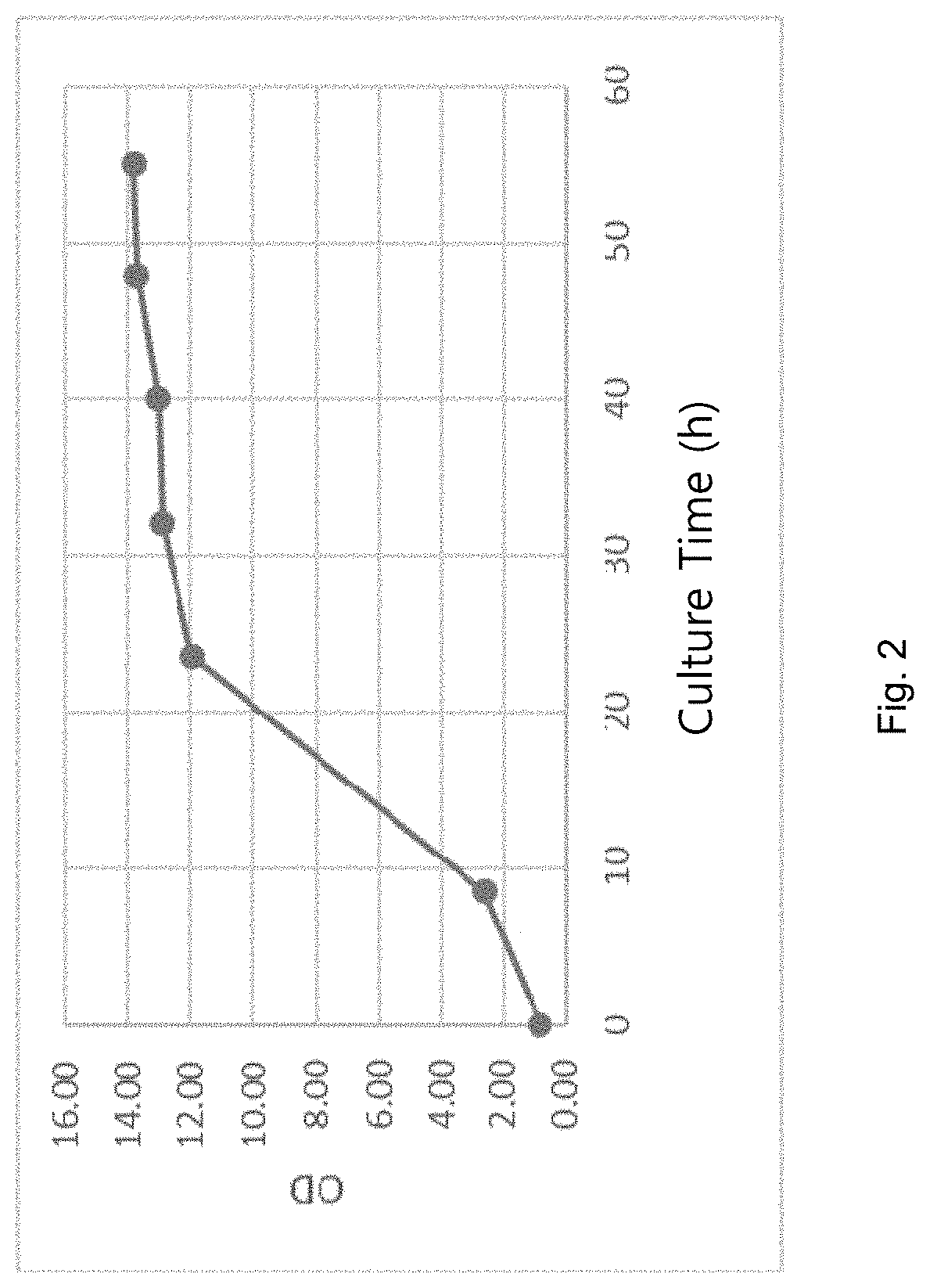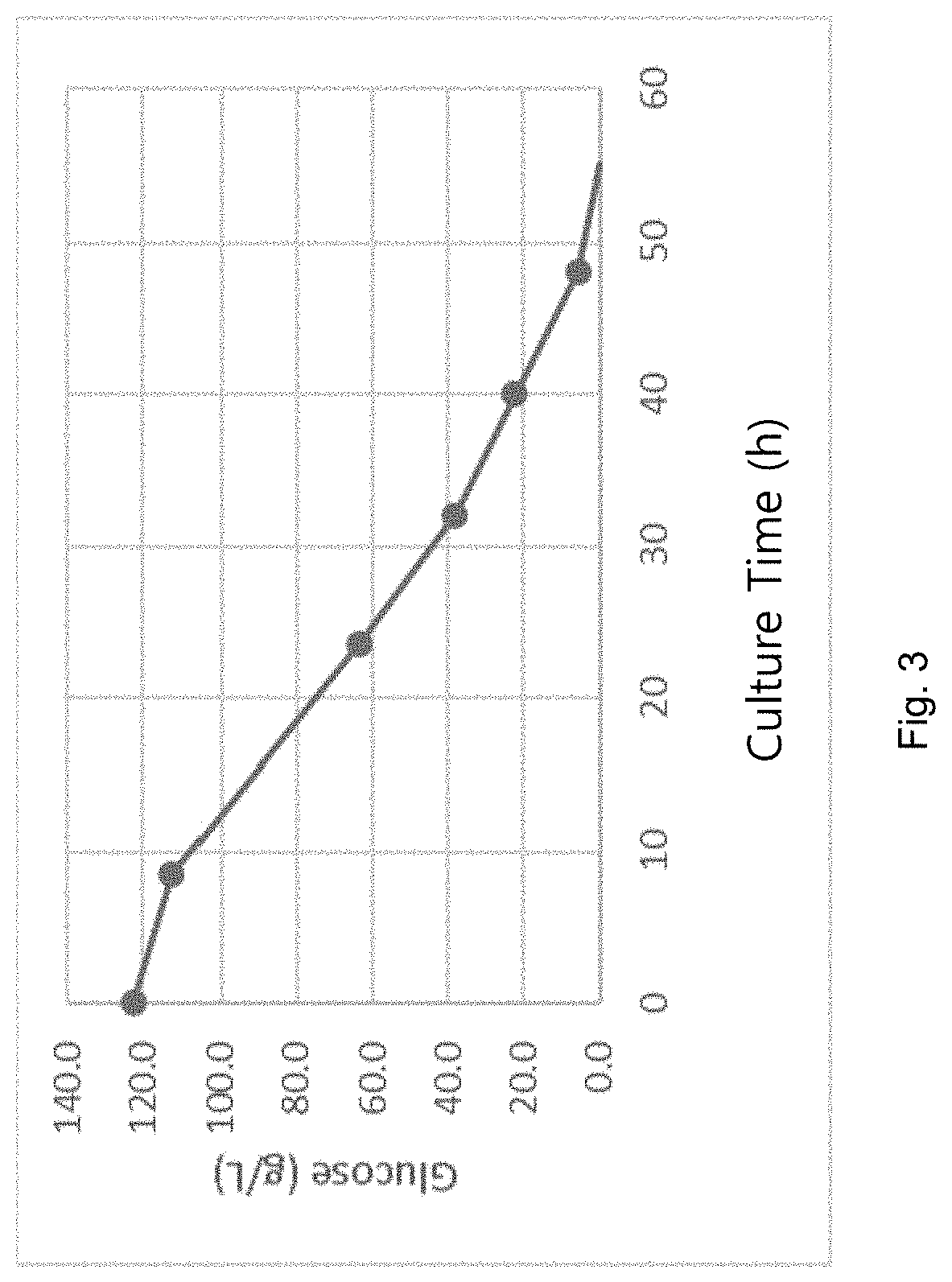Recombinant acid-resistant yeast with suppressed glycerol production and method of producing lactic acid using the same
a technology of glycerol production and lactic acid, which is applied in the direction of lyases, carbon-carbon lyases, peptides, etc., can solve the problems of deteriorating economic feasibility, large amount of expensive nutrients to be used, and deteriorating process efficiency, so as to achieve the effect of increasing the conversion yield of lactic acid to lactid
- Summary
- Abstract
- Description
- Claims
- Application Information
AI Technical Summary
Benefits of technology
Problems solved by technology
Method used
Image
Examples
example 1
of Glycerol-Producing Gene in Genome of Acid-Resistant Strain YBC
[0074]The present inventors selected strains having acid resistance through testing on various yeast strains and determined the strain having the best acid resistance, namely, the YBC strain, by adding lactic acid to a medium at the beginning of the culture of yeast strains and monitoring the growth and sugar consumption rate of microorganisms, and deposited the strain with accession number KCTC13508BP with the Biological Resource Center in the Korea Research Institute of Bioscience and Biotechnology.
[0075]Phylogenetic analysis showed that the YBC strain (KCTC13508BP) is a strain similar to S. cerevisiae, is diploid, and is Crabtree-positive.
[0076]g1544 and g5617 were identified as the genes annotated with GPD1 (glycerol-3-phosphate dehydrogenase 1) and GPD2, respectively, which are genes encoding an enzyme that converts dihydroxyacetone phosphate present in the genome of the YBC strain to glycerol-3-phosphate using S....
example 2
nt of Expression Level of GPD Gene
[0081]In order to confirm the expression levels of GPD1 (g1544) and GPD2 (g5617) of the YBC strain, RT-qPCR was performed using the following primers and the ALG9 gene as a housekeeping gene. The RT-qPCR method used in this example will be described as follows. RNA was extracted during the logarithmic growth phase of the YBC strain, and cDNA was produced using the RNA as a template. Primers specific to each of the target genes (GPD 1 and GPD2) and housekeeping genes (used as Ref genes) were synthesized and used to conduct qPCR. The Ref gene used in the experiment was ALG9, and the size of the fragment amplified by the primer that was used is 147±3 bp.
ALG9 forward primer:(SEQ ID NO: 22)CTTTGAGTGCAAGTATCGCCALG9 reverse primer:(SEQ ID NO: 23)TGTGTAATTGTTCACCAAAGCCGPD1(g1544) forward primer:(SEQ ID NO: 24)GTCGATTCTCATGTTCGTGCGPD1 reverse primer:(SEQ ID NO: 25)CTTAGCGACTTCAGTAGCGAGPD2(g5617) forward primer:(SEQ ID NO: 26)CATGTATCGAATCAAGTTCGTGGPD2 revers...
example 3
ion of Recombinant Acid-Resistant Yeast Strain from which GPD Gene is Removed
[0084]The g1544 gene, the g5617 gene, the g5443 gene and the g4356 gene, annotated with the GPD1 gene, the GPD2 gene, the GPP1 v1 gene and the GPP1 v2 gene, respectively, were removed from the genome of the YBC strain to construct a strain.
[0085]The acid-resistant yeast strains used to remove the genes were a YBC1 strain, constructed by introducing an LDH gene into the conventional YBC strain, not the YBC wild-type strain, and deleting an ADH (alcohol dehydrogenase) therefrom, a YBC2 strain capable of producing lactic acid at high efficiency and having suppressed ethanol production, constructed by removing the g3002-1 gene (PDC gene) from the YBC1 strain and introducing LDH thereinto, and a YBC4 strain having removed lactic acid consumption ability, constructed by introducing an LDH gene into the strain and removing g2947, a gene that consumes lactate.
[0086]YBC5 was constructed by removing the GPD1 (g1544) ...
PUM
| Property | Measurement | Unit |
|---|---|---|
| pH | aaaaa | aaaaa |
| pH | aaaaa | aaaaa |
| pKa | aaaaa | aaaaa |
Abstract
Description
Claims
Application Information
 Login to View More
Login to View More - R&D
- Intellectual Property
- Life Sciences
- Materials
- Tech Scout
- Unparalleled Data Quality
- Higher Quality Content
- 60% Fewer Hallucinations
Browse by: Latest US Patents, China's latest patents, Technical Efficacy Thesaurus, Application Domain, Technology Topic, Popular Technical Reports.
© 2025 PatSnap. All rights reserved.Legal|Privacy policy|Modern Slavery Act Transparency Statement|Sitemap|About US| Contact US: help@patsnap.com



